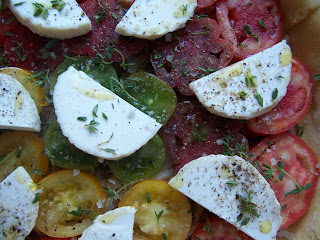I was in California when it happened, and only made it back to Chicago on Wednesday. My dad had just been discharged from the hospital. He looked great and sounded like his normal self, although a bit weary. He is on house arrest for at least a month and has already started to get bored. Luckily, he has our two dogs to keep him company. They are quite a handful.
I've been cooking my parents foods that are low fat and cholesterol-free since I got back (which has only been two nights, so it hasn't been a challenge). I decided to restart this blog so that when I go back to my apartment this weekend, I can easily share recipes with them and with my brother and sister, who might also want to incorporate more of this style of cooking into their repertoire.
I came up with these dairy and oil-free muffins after reading through a fair number of recipes. Before my dad's heart attack I had already begun experimenting with using applesauce and yogurt in place of butter in baking recipes with quite a bit of success, so I wasn't afraid to try cutting out all milk derivatives. Nonetheless, I was quite surprised at how well these turned out. They will never replace a rich, cakey muffin, but they are dense, nutty and moist. Perfect for a wholesome breakfast.
Surprisingly Good Healthy Banana Nut Muffins
INGREDIENTS
| Dry Ingredients | |
| 1 | c whole wheat flour |
| 1 | c wheat bran |
| 2 | tsp baking powder |
| 1/2 | tsp baking soda |
| 1/2 | tsp cinnamon |
| 1/4 | tsp nutmeg |
| 1/2 | tsp salt |
| Wet Ingredients | |
| 1/2 | c applesauce* |
| 2 | egg whites |
| 2 | large very very very ripe bananas |
| 1/4 | c honey |
| 1/2 | cup chopped walnuts |
| Turbinado sugar for garnish | |
| Add Ons | |
| 1/2 | c dried or frozen blue berries |
| 1/2 | c small chocolate chips |
| 1/2 | c chopped fresh/frozen cranberries |
| *Make sure its unsweetened | |
INSTRUCTIONS
| 1. | Preheat oven to 350 and either grease muffin pan or line muffin pan with baking cups. |
| 2. | Mix all dry ingredients together in a large bowl. Set aside. |
| 3. | In a small bowl, mash bananas until all large chunks are gone. Add the remainder of the wet ingredients and stir until mixed. |
| 4. | Pour the wet ingredients into the dry ingredients and stir until just combined. Stir in the walnuts and any other add-ons, such as frozen or dried blueberries or dark chocolate chips. |
| 5. | Scoop into muffin pan, just under filling the cups. They will rise only a little bit. Sprinkle with remaining walnuts and garnish each with a pinch of turbinado sugar. |
| 6. | Bake for 25 minutes or until a tooth pick inserted in the center of the muffins comes out clean. They will be a fairly deep brown color, but not burned. Cool for a few minutes, then transfer to a wire rack to cool further. They will keep well for several days in an air tight container or a few months if frozen. Refresh by sticking them in the toaster oven for a few minutes. |














